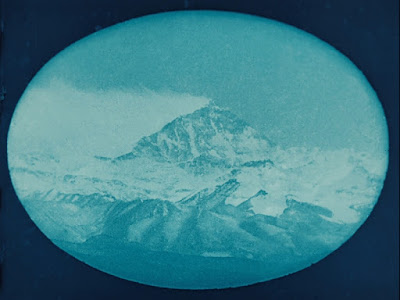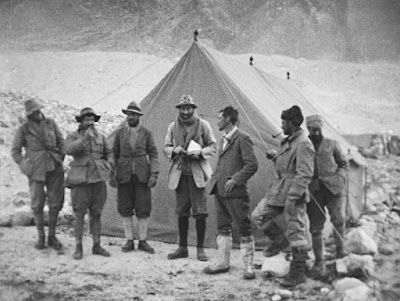(1924) Written and directed by Captain John Noel; Available
on Blu-ray and DVD
Rating: *****
“To us Everest was but a mountain – a thing of rock and ice and snow. To the Tibetans she was more – she was what they named her, ‘Chomolungma,’ ‘Goddess Mother of the World.’ Now could it be possible that something more than the physical had opposed us in this battle where human strength and western science had broken and failed?” – Captain John Noel (Excerpted from closing statement)
I’m honored to take part in the Rule Britannia Blogathon,
hosted by Terence Towles Canote of A Shroud of Thoughts, covering
the exceptionally influential and eclectic cinematic output of the United
Kingdom.
Mount Everest has long epitomized all things unattainable. Reaching its 29,032-foot crest, in the eyes of many, is tantamount to achieving an impossible goal. At the time The Epic of Everest was released, no one (or at least no one from the Western world) had successfully achieved this daunting feat. Captain John Noel, who joined the British army in northern India, specifically to document what he called “The Third Pole” (since the North and South poles had been successfully reached), set out to do just that. The Epic of Everest * chronicles Great Britain’s ill-fated third attempt to reach the peak (attempted previously in 1921 and 1922). Noel’s film covered the bulk of this arduous journey,** starting in India, and approaching the mountain from its northeast face, through Nepal. The 200-mile trek (walking roughly 12 miles per day), involved dozens of Sherpas, and a caravan of pack animals.
* Fun Fact #1: Noel documented the second attempt in his earlier 1922 film, Climbing Mount Everest. The filmmaker had to rent his own theater to exhibit the feature, due to lack of interest from distributors who felt it was missing a love interest.
** Fun Fact #2: According to Noel’s daughter, Sandra, the
filmmaker took along 14 cameras so that each pair of climbers could have a
small camera (with 2 minutes of footage) and a pocket camera, to capture images
from their unique vantage points. Not-So-Fun side note: The cameras and exposed
film that belonged to the victims are still atop Everest today (and presumably
intact). What secrets about the explorers’ last moments remain locked on that
lost celluloid?
Instead of concentrating on the individual personalities of the explorers, Noel chose to focus on the expedition itself, and their perilous climb. One character, however, emerges from the story, Everest itself. At one point, Noel describes the mountain with anthropomorphic terms, as an unfathomable, wrathful entity that “frowns upon us.” The gargantuan mountain dominates many of the shots as they inch closer toward their goal, its foreboding presence paradoxically beckoning and unwelcoming. Although we never get to know the explorers as individuals, there’s something uniquely human about their collective endeavors. Through a custom-made telephoto lens (built by Noel, himself), we witness the last footage of George Mallory and Sandy Irving,* two miles distant, as they make their final ascent, before vanishing. They appear as black specks against a sea of white, a somber epitaph for their endeavors.
* Not So Fun Fact: Mallory and Irving presumably died only
600 feet from their destination. Mallory’s body was discovered many decades
later, albeit with questions left unanswered (Did he reach the summit or didn’t
he?), but the location of Irvine’s body remains a mystery.
The BFI did a remarkable job restoring the film to its past
glory, while refraining from making it appear too pristine. In an age when
we’ve grown accustomed to crystal-sharp 4K images, it’s easy to look upon the scratches,
pops and grain with jaded eyes. But in this case, the technical limitations are
an asset. Filtered through the camera lenses of the time and equipment that
would be considered primitive by modern standards, we, the audience, are privy
to a secret world few of us could every fully understand. It’s a kind of magic,
from the pink-tinted opening shot of Everest, to scenes of Tibetan monasteries
and fortresses of Kampa Dzong and Shekar Dzong, built into towering cliffs. We
feel privileged to be able to be along for the ride. We’ve seen these magnificent
structures since, in color and high definition, but those images don’t compare
to what’s on display here. Noel’s film makes them appear ethereal, like
something out of a fantasy tale or a dream – all the better to ruminate about
how these structures were carved into the rock, centuries ago. The film takes
every opportunity to depict the harsh, unforgiving landscape of rock, glaciers
and snow, buffeted by punishing winds and unpredictable weather. In one of the
final scenes, clouds roll over craggy terrain covered in ice and snow, casting
a shadow like a death shroud. The modern score by Simon Fisher Turner
(commissioned for BFI’s 2013 re-release), enhances, rather than detracts from
the film. Turner’s soundtrack provides a contemplative aural backdrop, matching
the images beautifully, and incorporating authentic sounds from the era.
Is The Epic of Everest a tale of hubris? Man against the elements? Absolutely. But there’s much more to the story. The film portrays the explorers as interlopers in a world they scarcely understood. Rather than dismiss native superstitions, Noel considers how the Tibetan Lamas predicted they would not succeed in their quest, but they helped the team anyway (Perhaps the lamas knew that the Western explorers could only learn through their mistakes?). We’re constantly reminded of the sheer immensity of the undertaking for the benefit of a small group of privileged individuals. Considering the tremendous toll on human life and resources,* it’s not difficult to see how this expedition must have seemed pure folly, if not borderline suicidal. One aspect not adequately addressed by the movie is the risk to the lives of the many Sherpas who made the expedition possible (it fails to mention the fact that two perished). There’s a begrudging respect for the people that reside and thrive in such an inhospitable climate.
* Not So Fun Fact: To date, 305 climbers have lost their
lives,
attempting to scale the world’s tallest mountain. Of those 305, about 200
bodies have not been recovered, a grim reminder of the immense risks involved.
Why would anyone take such an enormous risk? For bragging rights to be the first, or simply to bask in the knowledge that they are doing something few would ever attempt? Most of us don’t have the luxury of time or money to travel around world, and even if we did, we would never be able to explore more than a fraction of all the corners of the globe. I’m aware that I’ll never climb Everest, but through documentaries such as these, I can experience the thrills and challenges vicariously. Considering the subject matter, it was a safe assumption that The Epic of Everest would be about man against nature, and the inevitable victory of our indomitable will against incalculable odds. Instead, it was something much more. It’s almost incidental that the explorers fell short of their goal to conquer Everest. The journey (physical and mental) is the thing. Noel’s meditative film is nothing short of astonishing, reminding us that our failings are just as important as our victories. There’s something ultimately comforting and humbling to know that in spite of our human arrogance and lofty aspirations, there are still things greater than us, vast and unknowable beyond our comprehension.
* Fun Fact #3: During the film’s initial release, it was originally exhibited as an immersive experience, including painted sets and a chorus of Tibetan Monks.
Sources for this article: “Introducing The Epic of Everest” 2008 featurette; “Fictitious Tales, Actual Odysseys,” by J. Hoberman, New York Times, October 11, 2015; “Captain Noel’s 1922 Conquest of Everest,” by David L. Clark, American Cinematographer, August 1990; “Our TeamClimbed Everest to Try to Solve its Greatest Mystery,” by Mark Synnott, National Geographic Magazine, July 2020







Fascinating. Why people do some of the things they are driven to attempt is beyond me, yet the idea is engrossing.
ReplyDeleteApparently for some people, "Because it's there," is reason enough. I'm with you, though. I'll leave stuff like this to the experts (and the foolhardy)!
DeleteIt's humbling to think of these explorers of the past, risking everything with equipment that from today's vantage point seems impossibly primitive, almost an invitation to disaster. It's gratifying to know that the BFI has honored these people and their film documents with such a great restoration. As for that "immersive" experience with the film's initial release, I'm wondering if in the near future exhibitors will have to come full circle and offer something similar to get people back in theaters...
ReplyDeleteHmm... I think you might have something there! The National Geographic article that I referenced includes a great graphic, illustrating the difference between the climbing equipment used in 1924 vs. now. Even with modern equipment, it's still a daunting challenge. BFI's restoration is truly a sight to behold.
DeleteHow good is this review, Barry?
ReplyDeleteI wasn't sure if I would find this film remotely interesting, but your review drew me in and now I think it sounds absolutely fascinating!
Thanks so much, John! I was already fascinated by the subject, but I had no idea I would be so enthralled. It's "armchair explorer" approved!
DeleteI will definitely have to check The Epic of Everest out. The story of explorers, with technology that would seem primitive compared to now, trying to conquer Everest sounds fascinating. Anyway, thank you for taking part in the blogathon!
ReplyDeleteIt's no small feat to scale Everest today, so I can only imagine what it must have been like, nearly 100 years ago. After watching this movie, I felt like I had a taste. Thanks a bunch for hosting another great blogathon, Terence!
DeleteThis sounds like a fascinating film, as so many of Everest are. But this one seems to have a special place in film – and mountain climbing/exploring – history.
ReplyDeleteI got a chill when you talked about the last footage of Irving and Mallory.
It's a truly fascinating, immersive experience. That final footage of Irving and Mallory is quite haunting, and the ending packs a wallop. Thanks for stopping by!
DeleteI wonder if this was the movie that so badly presented Tibetan culture that the government of that country forbade any follow-up expeditions...
ReplyDeleteFor more on the "conquest" of the Himalayas, I recommend "The World Beneath Their Feet: Mountaineering, Madness, and the Deadly Race to Summit the Himalayas" by
Scott Ellsworth
https://pureblather.com/2021/01/21/the-world-beneath-their-feet/
p.s. Countdown to Halloween sent me here.....
I wouldn't be surprised if that was the case. Thanks for the recommendation, by the way.
Delete